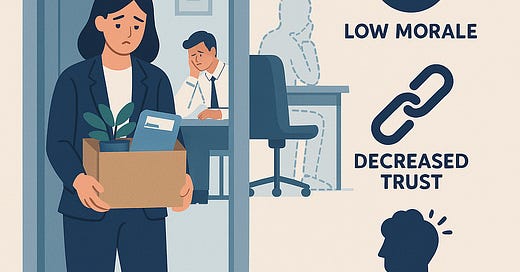Layoffs are a harsh reality in today’s volatile business landscape. While often driven by financial necessity or strategic realignment, their ripple effects extend far beyond the immediate cost savings. One of the most profound impacts is on company culture, the intangible glue that binds teams, drives engagement, and fuels productivity. This blog post explores how layoffs affect remaining employees and offers actionable strategies to maintain morale and preserve a positive workplace culture.
The Emotional Toll on Remaining Employees
When layoffs occur, the employees who remain, often referred to as "survivors," face a complex mix of emotions that can erode the foundation of a healthy company culture:
Fear and Job Insecurity: Survivors may worry about their own job stability, leading to anxiety and a defensive mindset. This fear can stifle innovation, as employees hesitate to take risks or propose bold ideas.
Guilt and Grief: Employees often feel survivor’s guilt, mourning the loss of colleagues with whom they shared bonds. This emotional weight can dampen enthusiasm and weaken team cohesion.
Increased Workload and Burnout: Layoffs frequently result in redistributed responsibilities, leaving remaining employees stretched thin. Over time, this can lead to resentment, fatigue, and disengagement.
Erosion of Trust: If layoffs are handled poorly—lacking transparency or fairness—employees may lose faith in leadership. A culture built on trust can quickly crumble when workers feel blindsided or undervalued.
These effects create a feedback loop. Disengaged employees are less productive, which can strain company performance, further threatening culture. Left unaddressed, this cycle can transform a once-vibrant workplace into one marked by cynicism and low morale.
The Broader Impact on Company Culture
Company culture thrives on shared values, collaboration, and a sense of purpose. Layoffs disrupt this equilibrium in several ways:
Weakened Team Dynamics: The departure of key team members can fracture relationships and disrupt workflows, leaving teams struggling to regain their rhythm.
Shift in Values: If layoffs appear to prioritize profits over people, employees may perceive a disconnect between stated values (e.g., “we care about our people”) and reality, leading to skepticism.
Reduced Engagement: A 2023 Gallup study found that high employee engagement correlates with 23% higher profitability, but layoffs often tank engagement as workers withdraw emotionally to protect themselves.
Ultimately, a damaged culture can lead to higher turnover, difficulty attracting talent, and a tarnished employer brand—consequences that may outweigh the short-term financial benefits of layoffs.
Strategies to Maintain Morale and Rebuild Culture
While layoffs are disruptive, proactive leadership can mitigate their impact and foster resilience. Here are five strategies to maintain morale and strengthen company culture post-layoffs:
Transparent Communication
Openness is critical. Leaders should clearly explain the reasons for layoffs, the decision-making process, and the company’s path forward. Avoid jargon or evasiveness. Honesty builds trust. Regular town halls or Q&A sessions can provide a forum for employees to voice concerns and feel heard.Acknowledge the Emotional Impact
Don’t sweep emotions under the rug. Acknowledge the difficulty of the situation, validate employees’ feelings, and offer support. This could include access to counseling services, team-building activities, or simply creating space for open dialogue. A 2022 SHRM survey found that 68% of employees value empathy from leaders during tough times.Reinvest in Employee Development
Show employees they are valued by investing in their growth. Offer training, mentorship, or clear career paths to restore confidence in their future with the company. This signals commitment to their long-term success, countering feelings of insecurity.Foster a Sense of Purpose
Reconnect employees to the company’s mission. Share success stories, celebrate small wins, and involve teams in shaping the organization’s next chapter. When employees feel their work matters, they’re more likely to stay engaged. For example, after a 2020 layoff, Salesforce rallied its workforce by emphasizing its commitment to community impact, which helped maintain morale.Prioritize Work-Life Balance
With increased workloads, burnout is a real risk. Encourage reasonable hours, offer flexible work options, and model healthy boundaries from the top. Recognition programs—such as shout-outs or small rewards—can also boost morale without breaking the bank.
Moving Forward: Building a Resilient Culture
Layoffs test the strength of a company’s culture, but they don’t have to destroy it. By addressing the emotional and practical needs of remaining employees, leaders can turn a challenging moment into an opportunity to rebuild stronger. A resilient culture—one rooted in trust, empathy, and shared purpose—can weather even the toughest storms.
The key is action over platitudes. Employees don’t need empty promises; they need tangible support and a clear vision for the future. By prioritizing transparency, development, and well-being, companies can not only maintain morale but also emerge from layoffs with a culture that inspires loyalty and drives success.




